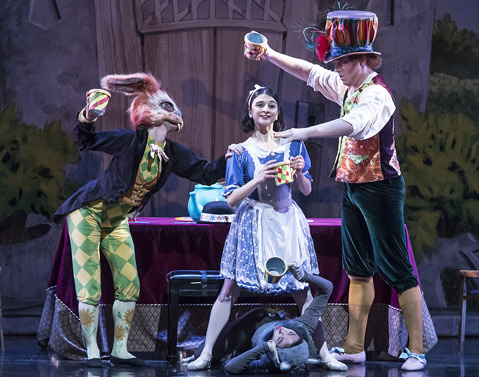Review: Alice in Wonderland at the Granada Theatre
State Street Ballet Reimagined Lewis Carroll on February 7

In 1862, a fellow named Charles Lutwidge Dodgson went on a boat trip with Henry Liddell and his three young daughters, ages 13, 10, and 8. Dodgson told them a story on that long afternoon that became the novel Alice’s Adventures in Wonderland (Lewis Carroll was Dodgson’s pen name). State Street Ballet’s (SSB) interpretation of this timeless story was choreographed by Robert Sund to the music of Jean Sibelius.
SSB’s Alice in Wonderland featured the company’s beautifully trained, confident dancers in fanciful costumes designed by Mary Etta Lang, Laila Borgman-Brouwer, and Ben-Oni Cortes. Sets designed by Daniel Nyiri were simple: a series of projections and backdrops featuring painterly trees, topiary, pedestals, and the like under blue skies dotted with perfect white clouds. The clean lines and visuals of the sets highlighted the clarity and simplicity of the choreographer’s vision. Sund’s choreography mixed elements of contemporary dance with the cool, poised grace of classical ballet.
Sarah, my 14-year-old ballerina daughter, watched the show beside me. As Alice (a convincingly childlike Lilit Hogtanian, starting out the show in flat ballet slippers, toning down her incredible technical mastery with soft, playful edges and a hint of preteen mischief) and her sister (Jade Barrad) gamboled about with their nanny (Samantha Schilke) and a smartly suited, bespectacled Lewis Carroll (Ryan Camou) in the opening scene, I wondered whether this would engage my daughter. Would its kid-friendliness bore my practically adult companion? Not a chance. As the White Rabbit (Meredith Harrill) took Alice down the rabbit hole, it was clear that this ballet was just as much fun for Sarah as it was for the littles who sat all around us dressed in their theatergoing best. We chuckled as the bottle labeled “Drink Me” dropped in from the flyspace above; we giggled at the comic antics of Tweedledee (Mauricio Vera) and Tweedledum (Sergei Domrachev); and we grinned at the utter weirdness of the hookah-smoking Caterpillar (Emma Nelson) as it boogied gamely atop its giant polka-dotted mushroom perch.
The story of Alice is a smart choice for a kid-friendly ballet. The tale is so twisted, so full of fantastical creatures and unexplainable plot shifts, that no kid would be likely to lean in and ask Mom or Dad what was going on. This story defies logic, reason, and cause-and-effect explanations; it’s best to just relax, be in the moment, and enjoy the ride, which is what most kids would rather do anyhow and what many adults go to the theater for: to get lost in beautiful moment after beautiful moment.
At the same time, Alice models resiliency and sass as she moves through her fantasy/fever dream. She stands up to the scratchy Cheshire Cat (Anna Carnes) and shoots some attitude at the White Knight (Camou) when he tries to get her to pose for a painting instead of playing with all her new friends. In the dance with the Flowers, Alice is presented with a pair of pointe shoes so that she can dance just like them. The moments where she laces on the shoes, wobbles a little, and then takes off with astounding grace may have hatched the dreams of a hundred baby ballerinas, who I imagine might now think that dancing en pointe is just that easy. Ah, let them dream — any one of them might be the Tiger Lily (Kate Kadow) or Butterfly (Deise Mendonça) of tomorrow.
Each set piece appeared as a reflection or reinforcement of each character or set of characters — a wonderful visual layering that was easy to digest for viewers of all ages. The use of projections to show Alice’s expansion and shrinkage was ingenious, as was the use of three layers of long, blowzy opaque silks stretched across the stage to denote water where Alice and the Tweedle twins played — and where Vera did a convincing series of laps, eliciting some of the biggest giggles of the show.
In Act II, the Mad Hatter (John Christopher Piel) and the March Hare (Leila Drake Fossek) brought their comic chops to the mix. Especially adorable as the Dormouse was Barrad, who sometimes stole the scene simply by falling asleep at the table.
At the story’s end, Alice was rescued by the White Knight from losing her head at the croquet party. She returned to the bucolic picnic with Carroll, having had either a very strange dream or a grand adventure down the rabbit hole.



